The handheld ultrasound scanner market is experiencing rapid growth driven by increasing demand for portable diagnostic solutions and advancements in imaging technology. Rising focus on point-of-care diagnostics, coupled with the growing need for real-time imaging in emergency and remote settings, is supporting adoption across both developed and emerging healthcare systems. The market is benefiting from improvements in wireless connectivity, image resolution, and battery efficiency that enhance clinical usability.
Integration with digital health platforms and AI-based image interpretation tools is further accelerating market penetration. Regulatory support for compact medical imaging devices and the expansion of telemedicine services are also contributing to widespread deployment.
The future outlook remains positive as healthcare providers increasingly prioritize mobility, cost efficiency, and accessibility in diagnostic equipment Growth rationale is grounded in the continuous transition from conventional cart-based systems to lightweight, user-friendly handheld scanners that deliver comparable performance while reducing infrastructure and operational costs.
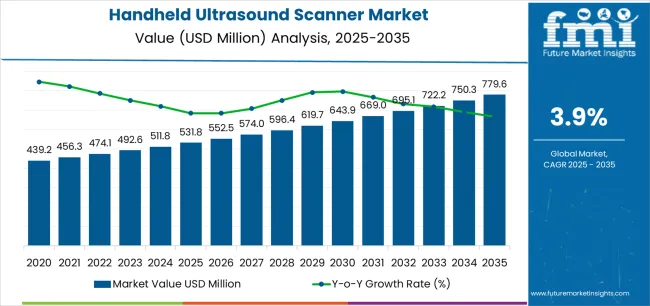
| Metric | Value |
|---|---|
| Handheld Ultrasound Scanner Market Estimated Value in (2025 E) | USD 531.8 million |
| Handheld Ultrasound Scanner Market Forecast Value in (2035 F) | USD 779.6 million |
| Forecast CAGR (2025 to 2035) | 3.9% |
The market is segmented by Modality, Display, and End User and region. By Modality, the market is divided into Wireless and Wired. In terms of Display, the market is classified into Color Display and Black & White Display. Based on End User, the market is segmented into Hospitals, Diagnostic Centers, Ambulatory Surgical Centers, and Others. Regionally, the market is classified into North America, Latin America, Western Europe, Eastern Europe, Balkan & Baltic Countries, Russia & Belarus, Central Asia, East Asia, South Asia & Pacific, and the Middle East & Africa.
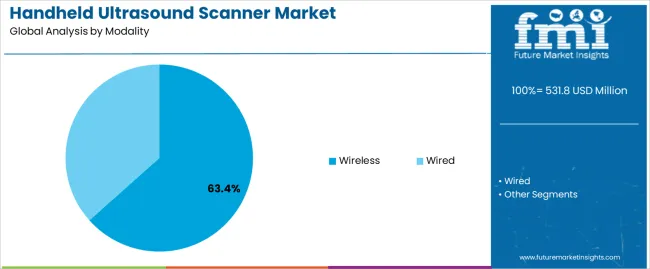
The wireless modality segment, holding 63.40% of the modality category, has emerged as the dominant segment due to its superior portability, flexibility, and ease of integration with smartphones and tablets. Market expansion is being reinforced by improvements in data transmission speeds and device interoperability that allow seamless sharing of imaging results.
Adoption has been particularly strong among emergency care, home healthcare, and rural medical units where mobility and convenience are critical. Manufacturers are focusing on optimizing signal quality, power consumption, and user interface design to enhance diagnostic accuracy.
Cost efficiency and simplified maintenance have further encouraged replacement of wired systems Continuous innovations in wireless technologies and broader acceptance across medical disciplines are expected to sustain the segment’s leadership and drive ongoing market penetration over the forecast period.
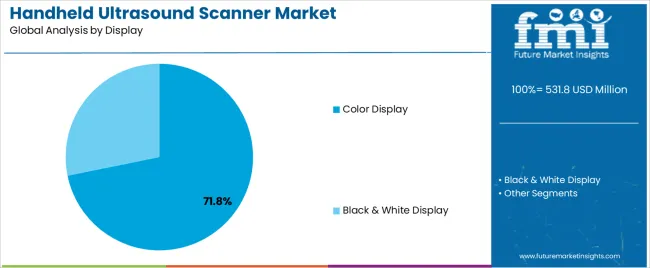
The color display segment, accounting for 71.80% of the display category, is leading the market owing to its superior imaging clarity and enhanced visualization capabilities that enable accurate diagnosis. Adoption has been driven by improvements in high-resolution screen technology and user-friendly interfaces that enhance workflow efficiency.
Color display units support advanced imaging modes such as Doppler and 3D visualization, increasing their suitability for complex diagnostic applications. Widespread integration into wireless and portable devices has strengthened their utility across diverse clinical environments.
The preference for color imaging in both general and specialized medical examinations has reinforced its dominance Continued technological upgrades aimed at improving brightness, contrast, and durability are expected to sustain segment growth and ensure strong market performance across diagnostic settings.
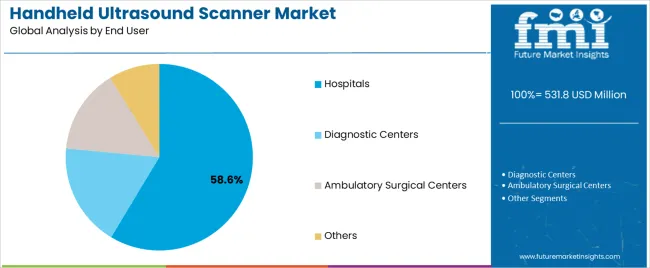
The hospitals segment, representing 58.60% of the end user category, has maintained its leading position due to high patient throughput and the need for rapid, point-of-care diagnostics within institutional settings. Adoption has been supported by large-scale procurement initiatives, budget allocations for portable imaging equipment, and growing clinical reliance on handheld devices for bedside examinations.
Hospitals benefit from integration of handheld ultrasound scanners into existing diagnostic systems, enhancing workflow efficiency and patient management. Training programs and partnerships with device manufacturers have strengthened user competency, promoting broader utilization.
The segment continues to dominate due to consistent investment in technology modernization and expanding applications in emergency, cardiology, and obstetrics departments Sustained hospital adoption is expected to reinforce overall market stability and provide a solid foundation for long-term growth.
Artificial Intelligence Integration Surges in the Market
Integrating artificial intelligence (AI) into portable ultrasound scanners is a strategic step to distinguish offerings and gain market share. Manufacturers can boost their gadgets' diagnostic precision and efficacy by using AI algorithms for picture interpretation and analysis. This technology-driven strategy enhances the performance of handheld ultrasound scanners and positions enterprises as pioneers in the competitive medical imaging industry, resulting in increased consumer uptake and brand loyalty.
Leveraging this trend, Exo launched an AI-powered Iris System in September 2025. Iris' handheld probe has a 150-degree field of vision, which its inventor claims can cover a whole liver or an entire fetus, as well as a depth of 30 centimeters.
Rising Importance of Preventive Healthcare Presents Opportunities in the Market
The focus on preventative healthcare presents a business opportunity for manufacturers of handheld ultrasound scanners. Companies can take the lead in supporting preventive healthcare initiatives by offering devices to detect illnesses early on in screening programs targeting cancer, cardiovascular disorders, and other common conditions.
This strategy has a unique selling proposition that appeals to healthcare professionals, organizations, and stakeholders involved in preventive healthcare methods, and it is in line with the larger trend toward proactive healthcare.
Manufacturers Capitalize on Smartphone Connectivity and Mobile Apps
Adopting smartphone connections and creating specific mobile applications for handheld ultrasound scanner is a calculated move that can enhance market appeal and product use. Businesses can boost workflow efficiency and patient care by giving healthcare personnel fast access to imaging data and analysis tools through seamless connectivity with smartphones and tablets. This customer-focused strategy increases the product's value and encourages brand loyalty, propelling market penetration and revenue growth.
Recognizing this tendency, in January 2025, Clarius Mobile Health, located in Canada, announced the launch of their groundbreaking Clarius PAL HD3 wireless portable whole-body ultrasound scanner in Australia. Clarius is as small as an iPhone and compatible with iOS and Android smartphones, allowing for easy patient transfer.
| Trends |
|
|---|---|
| Opportunities |
|
| Challenges |
|
| Segment | Color Scanner (Product) |
|---|---|
| Value Share (2025) | 61% |
Based on the product, the color scanner segment holds 61% of market shares in 2025.
| Segment | Hospitals (End User) |
|---|---|
| Value Share (2025) | 37% |
Based on end user, the hospitals segments captured 37% of market shares in 2025.
| Countries | Value CAGR (2025 to 2035) |
|---|---|
| United States | 2.5% |
| Germany | 1.50% |
| Thailand | 5.2% |
| Malaysia | 4.7% |
| India | 5.70% |
The demand for handheld ultrasound equipment in the United States is projected to surge at a 2.5% CAGR through 2035.
The sales of handheld ultrasound equipment in Germany are anticipated to rise at a 1.50% CAGR through 2035.
The handheld ultrasound scanner market growth in Thailand is estimated at a 5.2% CAGR through 2035.
The demand for handheld ultrasound scanners in Malaysia is anticipated to rise at a 4.7% CAGR through 2035.
Handheld ultrasound scanner sales in India are predicted to surge at a 5.70% CAGR through 2035.
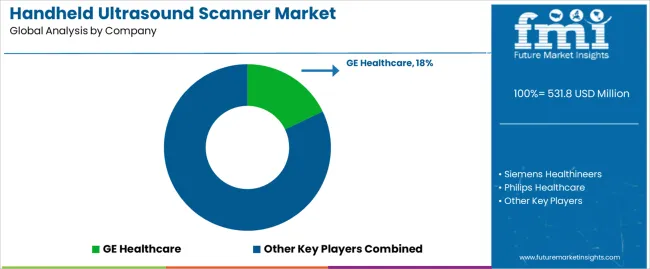
The handheld ultrasound scanner market is highly competitive, with prominent companies contending for dominance and strategic positioning. Prominent global companies, including GE Healthcare, Siemens Healthineers, and Philips Healthcare, influence the market owing to their vast product portfolios, technological expertise and established brand recognition. These industrial behemoths invest heavily in R&D to bring novel features, improve product performance, and preserve a competitive advantage.
Recent Developments
The global handheld ultrasound scanner market is estimated to be valued at USD 531.8 million in 2025.
The market size for the handheld ultrasound scanner market is projected to reach USD 779.6 million by 2035.
The handheld ultrasound scanner market is expected to grow at a 3.9% CAGR between 2025 and 2035.
The key product types in handheld ultrasound scanner market are wireless and wired.
In terms of display, color display segment to command 71.8% share in the handheld ultrasound scanner market in 2025.






Our Research Products

The "Full Research Suite" delivers actionable market intel, deep dives on markets or technologies, so clients act faster, cut risk, and unlock growth.

The Leaderboard benchmarks and ranks top vendors, classifying them as Established Leaders, Leading Challengers, or Disruptors & Challengers.

Locates where complements amplify value and substitutes erode it, forecasting net impact by horizon

We deliver granular, decision-grade intel: market sizing, 5-year forecasts, pricing, adoption, usage, revenue, and operational KPIs—plus competitor tracking, regulation, and value chains—across 60 countries broadly.

Spot the shifts before they hit your P&L. We track inflection points, adoption curves, pricing moves, and ecosystem plays to show where demand is heading, why it is changing, and what to do next across high-growth markets and disruptive tech

Real-time reads of user behavior. We track shifting priorities, perceptions of today’s and next-gen services, and provider experience, then pace how fast tech moves from trial to adoption, blending buyer, consumer, and channel inputs with social signals (#WhySwitch, #UX).

Partner with our analyst team to build a custom report designed around your business priorities. From analysing market trends to assessing competitors or crafting bespoke datasets, we tailor insights to your needs.
Supplier Intelligence
Discovery & Profiling
Capacity & Footprint
Performance & Risk
Compliance & Governance
Commercial Readiness
Who Supplies Whom
Scorecards & Shortlists
Playbooks & Docs
Category Intelligence
Definition & Scope
Demand & Use Cases
Cost Drivers
Market Structure
Supply Chain Map
Trade & Policy
Operating Norms
Deliverables
Buyer Intelligence
Account Basics
Spend & Scope
Procurement Model
Vendor Requirements
Terms & Policies
Entry Strategy
Pain Points & Triggers
Outputs
Pricing Analysis
Benchmarks
Trends
Should-Cost
Indexation
Landed Cost
Commercial Terms
Deliverables
Brand Analysis
Positioning & Value Prop
Share & Presence
Customer Evidence
Go-to-Market
Digital & Reputation
Compliance & Trust
KPIs & Gaps
Outputs
Full Research Suite comprises of:
Market outlook & trends analysis
Interviews & case studies
Strategic recommendations
Vendor profiles & capabilities analysis
5-year forecasts
8 regions and 60+ country-level data splits
Market segment data splits
12 months of continuous data updates
DELIVERED AS:
PDF EXCEL ONLINE
Handheld Electrostatic Meter Market Size and Share Forecast Outlook 2025 to 2035
Handheld Tagging Gun Market Forecast and Outlook 2025 to 2035
Handheld Imaging Systems Market Size and Share Forecast Outlook 2025 to 2035
Handheld XRF Analyzers Market Size and Share Forecast Outlook 2025 to 2035
Handheld Police Radar Guns Market Size and Share Forecast Outlook 2025 to 2035
Handheld DNA Reader Market Size and Share Forecast Outlook 2025 to 2035
Handheld Robotic Navigation Market Analysis - Size, Share, and Forecast Outlook 2025 to 2035
Handheld Mesh Nebulizer Market Size and Share Forecast Outlook 2025 to 2035
Handheld Chemical and Metal Detector Market Size and Share Forecast Outlook 2025 to 2035
Handheld Dental X-Ray Systems Market Analysis - Size, Share, and Forecast 2025 to 2035
Handheld Concrete Saws Market Size and Share Forecast Outlook 2025 to 2035
Handheld Point of Sale Market Analysis - Size, Share, and Forecast Outlook 2025 to 2035
Handheld Arthroscopic Instruments Market Growth – Trends & Forecast 2025 to 2035
Handheld Marijuana Vaporizer Market Insights – Demand & Forecast 2025-2035
Handheld Device Accessories Market
Handheld GPS Units Market
Handheld DC Torque Tools Market
Handheld Retinal Scanners Market
Rugged Handheld Electronic Devices Market Analysis – Size, Share & Forecast 2025 to 2035
Cordless Handheld Cultivator Market Size and Share Forecast Outlook 2025 to 2035

Thank you!
You will receive an email from our Business Development Manager. Please be sure to check your SPAM/JUNK folder too.
Chat With
MaRIA